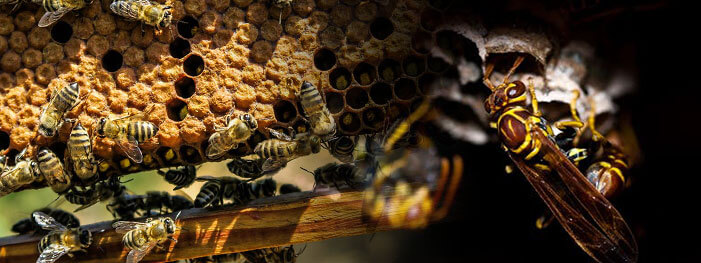
Bees and wasps hold a great importance to the ecosystem but can turn into a pest if they inhabit the wrong places. What should you do if you suspect an infestation on your property? Truly Nolen Canada helps you assess if the situation is severe enough to call it an infestation, or if perhaps it’s a different type of insect. The distinction between the different type of wasps and bees is important to determine the right strategy and pest control methods.
Which Type of Wasp/Bee Are You Dealing With?
Before taking any actions against the flying insect in your home, you should know a couple of important differences between bees and wasps:
● While wasps have thin and smooth bodies, bees have somewhat fuller bellies and hairy bodies. Wasps tend to have a bright yellow color, while bees look more brownish.
● Wasps have stingers they can use multiple times, while bees leave their stinger underneath the skin. After stinging, bees will die as their stomach is attached to their stingers.
● Bees can produce honey, while wasps can not. Typically, bee colonies can number up to 75000 bees; while wasps live in smaller colonies that can consist of up to 10000.
Discovering a bee or wasps nest can create concern, especially if they’re near your family. It’s important to stay calm if bees or wasps on your property, despite feeling concerned for the safety of your family and pets. Though you might feel like attempting to knock the nests down on your own, it’s important to refrain from doing so. Most people are unfamiliar with the proper way to remove a nest, putting them at great risk of being stung. While Canada hosts several types of wasps, not all of them are equally dangerous. For example, the ones that live in solitude are less dangerous than those that live in colonies, which is an important thing to know when planning the removal steps.
There are numerous reasons why bees can become a nuisance. They may nest in tree hollows, or near swimming pools. While controlling wild colonies is simple for a professional, as similar strategies for removing insects apply to them as well, honey bees are somewhat more demanding. If you encounter honey bees on your property, call an expert pest removal company as soon as possible.
Truly Nolen’s Bee and Wasps Control Strategies
Once invited into your home, a Truly Nolen technician will confirm the presence of a nest or a swarm, after which we’ll identify the type of insect. Assessing the severity of the infestation is an important step, after which we’ll give you a report on the situation and the next steps towards removing the nests.
Truly Nolen will most likely aim to control the wasps during June, once the queen establishes the colony and the colony is relatively small. While smaller nests are easier to destroy, they’re harder to find. This is why Truly Nolen chooses to deal with them while their activity is low. Here’s how our pest control process works:
- Determine the Action Plan – After an inspection, we will plan out the entire removal process and give you a full report.
- Communicate – We will inform you about the actions we plan on taking, and the progress you can expect within 24-48 hours.
- Control and Prevention – Truly Nolen will apply the planned strategies to eliminate the nests or swarms. Depending on the size of the nest, our technicians will wait until it’s empty to remove it. To prevent insects from building nests in the same spots, we might also install one or multiple decoy nests. Wasps, in particular, are extremely territorial and will not build a nest in the same area as another nest.
Scared About Wasps and Bees on Your Property? Call Truly Nolen
With a variety of types of bees and wasps, it should be clear by now that trying to eliminate the nest on your own is very dangerous. Even the more docile species may attack and sting if they feel like their nest is threatened. Proper pest control requires understanding their living cycle, which is why calling Truly Nolen is the best decision you can make.
